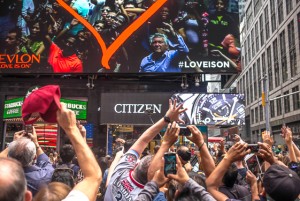Cell-phones are this generation’s cigarette. That was one analysis provided by Jerry Holsopple and Linford Stutzman to students participating in an October Living and Learning Forum at Eastern Mennonite University. Holsopple, a visual and communication arts professor, and Stutzman, professor in the Bible and religion department, teamed up to talk about “selfie culture” and the potential side-effects of this social phenomenon.
Stutzman opened by re-telling the Greek myth of Narcissus, a man so entranced by his own reflection in a pond that he drowned trying to reach his reflection. Narcissus’s story is a metaphor for the current trap our own society is falling into, Stutzman said. Individuals in our society are so preoccupied with themselves that they are not aware of the fragmentation of genuine human relationships.
Holsopple talked about how self-centered the action of taking the photo is: “Who is the subject of the photo? You are.” Even if you take a photo with other people, Holsopple argued, they are just an “afterthought,” and “background things.”
He described the selfie as a way to document where you are and how you look, to show everyone how amazing and exciting your life is. Then the act of “liking” is equated with self-worth.

“If 43 people like [a selfie], they like me,” Holsopple added.
Holsopple explained another reason why our culture values selfies is because we are enamored with the idea of our persona, which can be created and controlled to look a certain way on social media. We tend to shy away from showing the more bland moments on social media. Even in a selfie taken to show how bored you are, people will smile and compose themselves to meet the persona that has been created.
“We cannot live with the discomfort of people not liking us,” Holsopple said.
It’s possible, he continued, that we do not want to know our true selves, which is a “frightening” prospect. It is much easier is to create and hide behind the persona.
Stutzman ended the presentation with a comparison between Narcissus, Jesus and “you and I.” All of these entities find and affirm identity in different ways: Narcissus only from himself (“I am my image, who cares who others say I am?”), Jesus from the others around him and God (“I am who I say I am; who do you say that I am?”), and humans from self, others and God. This last relationship is important, Stutzman said. “We are tempted to create our own image through what others say we are, but we must always remember who we really are.”
We only get selective feedback from people online, feedback which is limited by the ability to “like” and the fact that we don’t put “our whole selves out there,” he added.

Being affirmed as our “whole selves” is important, Holsopple said. “I would rather be loved by the people who know me than liked by the people who do not know me.”
The forum also included Holsopple’s photos of people taking selfies in New York City, a sight which sophomore Rachel Sturm called ” baffling.”
“So many people took selfies instead of the beautiful scenery and the different environments of New York City,” she said. “I believe our society is … living behind a phone.”
This article is reprinted from the Oct. 15, 2015 issue of the Weather Vane.

A great article, I agree with it 100%.
Scary reality. Great analysis.
‘Wish I could have heard these two share their insights! I did recently read a fantastic book on a related subject, Rebecca Konyndyk DeYoung’s VAINGLORY: THE FORGOTTEN VICE. ‘Very challenging……